|
|
|
The term "Turkish incunabula" refers to the first books printed in Turkey with Arabic/Turkish movable types.
They were issued from the printing-office of Ibrahim Efendi, called Ibrahim "Müteferriqa" in Constantinople
from 1728 to 1742, during which time 17 works were printed.
Hebrew, Greek and Syrian printing presses existed already for the Jews and Christians, but within the Islamic sector, opposition from the religious authorities and the guilds of copyists and calligraphers had been too strong. But at the early 18th century, Turkish society was much influenced by European, especially French science and culture. The first Turkish ambassador to France, Mehmed Efendi and his son Said Efendi, took an interest in the printing technique, and back in Turkey secured the approval of the Grand Vizier, the Mufti's decree and the Sultan's command with permission to set up a press provided no religious (including legal) works were printed. Printing presses were imported from France, typefaces from Holland, workmen from Vienna, and printing started in 1728 with a large Arabic dictionary in Turkish translation. The man in charge was Ibrahim Efendi, who was born in Transylvania but had been taken prisoner, entered the civil service and advanced to müteferriqa, i.e. "steward" attached to the Sultan's personal staff. The printing-office was in operation until 1742 when Ibrahim went over to diplomatic service until his death in 1745. In 1758 his son printed a second edition of the dictionary, and that was the end of this printing-office. 12 works had been shipped to Sweden in 1736 through ambassadors Carleson and von Höpken and arrived to the Royal Library the same year. In 1739 similar dispatches arrived to the university libraries at Uppsala and Lund. In 1807 the Royal Library acquired another set of the incunabula collection through Ulric Celsing. Printing wasn't restarted in Turkey until 1783, but then it continued. One of the products of that second period was the Cedid Atlas Tercümesi 1803, after British cartographer William Faden, which was acquired by Hedenborg and arrived to the Royal Library in 1832. The Turkish booktitles below are given in Arabic transliteration. |
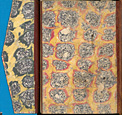
|
|
1. Krusinski: Chronicle of the Afghan revolt.
Targumat-i Tarīh-saijāh dar bajān-i zuhūr-i Agwānījān "Translation of A traveller's chronicle explaining the Afghan revolt ...", generally known under the title Tarīh-saijāh (or Tarīh-i) Agwānījān. 1729 [Inc.Turc.3B]. The author, Judasz Tadeusz Krusinski (1675-1756) was a Jesuit from Poland, secretary and interpreter to bishop Bernabita of Isfahan. This is probably the author's translation of his own Latin text, which was later published in Leipzig 1731, being an account of the war events in Persia in the 1720's, the Afghan invasion and the fall of the Safavid dynasty. Covers with hatip-ebrūsu marble, named after Mehmet Efendi (d. 1773), who was preacher (hatip) in the Aya Sofia mosque and one of Turkey's greatest marbled paper artists. |
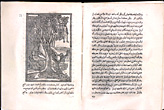

|
|
2. Tales of the West Indies.
Tarīh al-Hind al-garbī, al-musammā bi-Hadīt-i nau. "The History of the West Indies, called New Tale". Engraved maps and tables, 13 woodcut illustrations. Unknown author. 1730 [Inc.Turc.4]. A general geography, a report on the discovery of the New World and a collection of fables, wrongly attributed to Haggi Halifa (Katib Ēelebi). The woodcut illustrates the 1001 Night story of the Wak-wak island with trees carrying women fruits falling down when ripe, screaming wak-wak! Toderini's History of Turkish literature 1787 says that this story was so popular in Turkey that official festivals included trees with cardboard figures of women which were made to fall down likewise screaming wak-wak! Lit.: Goodrich, T.D., The Ottoman Turks and the New World : a study of Tarih-i Hind-i garbi and sixteenth-century Ottoman Americana. Wiesbaden 1990. |

|
|
3. Suhailī: History of Egypt.
Tarīh-i Misr al-gadīd - Tarīh-i Misr al-qadīm li-Suhailī afandī "Recent... ancient history of Egypt by Suhaili Efendi". 1730 [Inc.Turc.6]. The author Suhailī was secretary at the Cairo Divan (Supreme Court) ca 1630. - The 'ancient' histstory goes from the Creation until 1516, the 'recent' is on the Turkish conquest of Egypt 1517. To this work belongs a map of Egypt copied from Janssonius 1658. - Marbled cover: tulip flowers in red and green with black edge on grey background. |

|
|
4. Ibrahim Müteferriqa: Basic Principles of Leadership.
Usūl al-hikam fī nizām al-umam. "Basic principles in the science of leadership of people", sometimes called Nizāmīe. 1732 [Inc.Turc.9]. Pleading for the improvement of the unsatisfactory tactics and discipline of the Turkish army. - Lāle-ebrūsu marble, 'tulip-paper', was created within the school of Mehmet Efendi and is considered the most difficult within the art of marbling. The pattern is created with a needle or horsehair. |
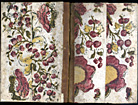
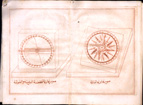 |
|
5. On magnetism.
Fujūdāt-i miqnātīsīja "On magnetic fluxes" (or possibly: "On the blessings of magnetism"). Unknown author. 1732. [Inc.Turc.10]. Covers with calico paper, floral pattern stamped with paste colours in red, green, yellow and black. |
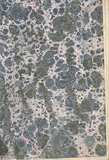
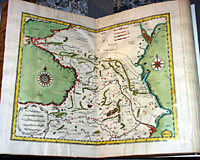
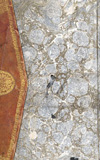
|
|
6. Kātib Ēelebī: World Mirror. A sumptuous work of geography.
Kitab Gihān-numā li-Kātib Calabī. "Mirror of the world by Kātib Ēelebī". 1732. [Inc.Turc.11]. Author: Mustafā Ibn 'Abdallāh, called Hāggī Halīfa or Kātib Ēelebī (1609-1657) and Abū Bakr Ibn Bahrām, called Ibn Behrām (d. 1691). This was for long the Ottoman standard work of geography and incorporated the contemporary European geographical knowledge. It was the most esteemed of the works from the presses of Constantinople and indeed attractive because of its fine engravings. Contemporary Turkish goat-skin binding, gold- and blind-tooled. Marble flyleaves. |

|
|
7. 'Umar from Novi: The war in Bosnia 1736-1739.
Ahwāli gazawāt dar dijār-i Būsna "Circumstances concerning the fighting in the province of Bosnia". 1741. [Inc.Turc.15]. On inside cover Ulric Celsing's signature and label with title in Turkish and French. Boards covered with marbled paper: floral pattern in orange, dark blue, light blue and yellow. Literature: Rohnström, J., "The turkish incunabula in the Royal Library, Stockholm. A catalogue". In: Turcica et orientalia : studies in honour of Gunnar Jarring. Stockholm 1988. |